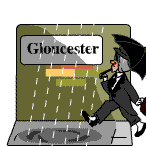Gloucester, Gloucestershire, UK
Created | Updated Jan 28, 2002

Gloucester is a small cathedral city based on the banks of the river Severn in the west of England. It has existed for 2000 years although evidence has been found that the first inhabitants settled in the area in 3500 BC. It was called Caer Glow, or splendid city, by the Celts and Glevum by the Romans.
The people of Gloucester like to think that the city is famous for many things and, in the past, it has been. But it has not been important since the transport infrastructure in England made canals redundant. It's an interesting place to visit, there is lots to see there and plenty of history but it's not a place to live unless you're retired. The inhabitants would have been just as happy if nothing of consequence ever happened. They certainly give the feeling that they have never liked change. Almost all of the old pubs are frequented by locals whose families have drunk there for generations. It is not that outsiders and the modern world aren't tolerated, they just aren't welcomed with open arms.
A Potted History
Gloucester gained importance in AD43 when the Romans settled in the city, building a fortress in Kingsholm. They maintained control of the city until AD577 when it was regained by the Saxons. Its strategic importance for the Romans and the Saxons lay in its position, which was convenient for keeping an eye on the marauding Welsh on the other side of the river. The Romans left a big imprint on the city - 30 Roman villa remains can be found throughout Gloucestershire. Dig down beneath any of the modern buildings in the city centre and you're likely to find Roman remains of some kind. In the Eastgate Precinct there's a viewing gallery for the Roman structures and mosaics that were found when the area was pedestrianised.
After the Norman Conquest (1066), Gloucester became England's second city after London. It was the site where the Domesday Book was ordered by William The Conqueror. Between 1043 and 1062, and again in 1378 Parliament was based in Gloucester. The city was also the place where Henry III and Lady Jane Gray were crowned. However, only Henry's crowning was confirmed and officially recognised, whereas Lady Jane Gray reigned for nine days and was ousted by Mary Tudor.
The city has its own martyr, Bishop John Hooper, who stood in defiance of the Catholic Mary Tudor and was burned at the stake as a consequence. Local legend has it that Mary came to watch the burning secretly and that her face can still be seen in the window from where she watched. Gloucester was also a Cromwellian stronghold during the English Civil war. The war caused Gloucester's first set-back in history for, when Charles II was crowned in 1661, the city of Gloucester had most of its lands confiscated as punishment.
Gloucester has always had a strong religious presence. Its oldest church, St Mary de Lode, was built on Roman foundations and is presumed to be one of the earliest known sites of Christian worship. The oldest standing building in Gloucester is St Oswald's Priory that was dedicated to the martyred King of Northumbria. There was a Dominican friary at Blackfriars, a Franciscan friary at Greyfriars and there is still a monastery at nearby Prinknash Abbey.
There's a maze of tunnels, under Gloucester, most of them blocked, that link the friaries, pubs and cathedral so the priests and monks could travel freely without being seen. At this time, priests and monks could drink and marry and were often just educated men who were second sons and, therefore, would inherit no land.
There are at least three haunted pubs in Gloucester:
The Dick Whittington/Black Cat which was an aldermaston's house
The Fleece Inn which was a staging post
The Inner Court, an inn where half of the rooms have been unused for centuries due to frequent hauntings
The cathedral is a worthy reason to visit Gloucester. It stands tall above the city and is a beautiful building. It's the resting place of Edward II and also contains the largest known Medieval stained glass window in Britain. The window is big enough to play tennis on and is a memorial to the battle of Crecy.
Gloucester's importance faded in Georgian times when Cheltenham became much more fashionable town, but it regained a lot of its stature during the Victorian era when it became a major port because of the Gloucester-Sharpness canal. This was the gateway for waterborne traffic to and from the Midlands and as the canal fed into the Severn which has the highest tide in the world, there was easy access to all the major shipping routes.
Famous Faces
There have been many famous faces from Gloucester. Well, actually there have been many famous faces from Gloucestershire, but Gloucester itself has only three claims to fame.
From the nursery rhyme:
Dr Foster went to Gloucester
In a shower of rain.
He stepped in a puddle
Right up to his middle
And said I'll never go there again!Dick Whittington was a Gloucester lad born in 1350. Most people think he was a fictional character but he wasn't, and he did indeed become Lord Mayor of London.
Fred West, murderer of countless women and children lived at 25 Cromwell Street.
So basically there are three famous people from Gloucester, all of them are dead and the only one people know isn't fictional was a mass murderer.

